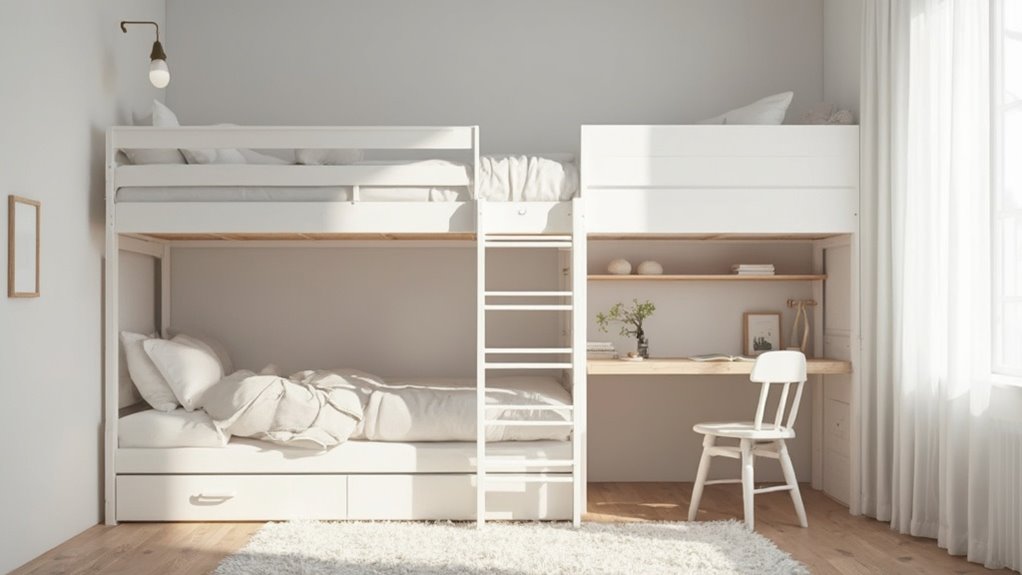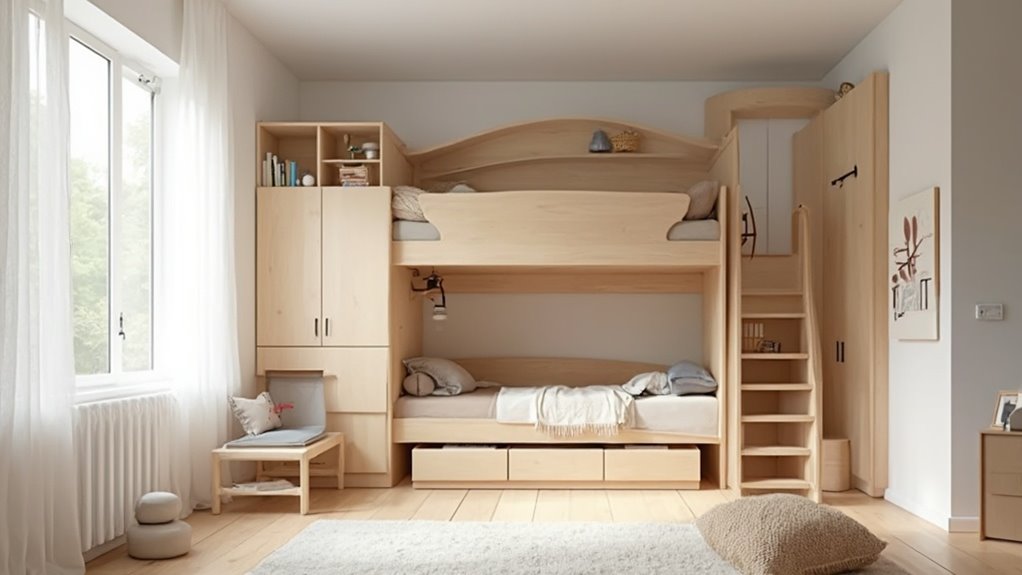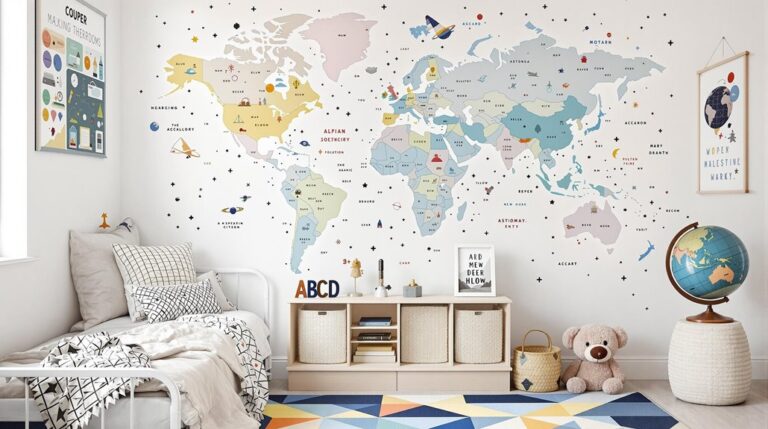Bunk beds are the ultimate space-saving solution for kids' bedrooms, transforming cramped quarters into dynamic, multi-functional zones. By vertically stacking sleeping surfaces, these ingenious designs liberate valuable floor space for play, study, and storage. L-shaped and loft configurations create additional room for desks, shelves, and hidden drawers, while modular systems adapt as children grow. Strategically positioned guardrails and age-appropriate designs guarantee safety, while customizable options allow for personalized aesthetics that reflect individual style. With smart placement and thoughtful selection, bunk beds can turn a small bedroom into a versatile sanctuary that maximizes every square inch. Curious about revealing your room's full potential?
Briefly keys
- Utilize L-shaped and loft bunk bed designs to create additional floor space for play, study, and activities in the children's room.
- Incorporate integrated storage solutions like under-bed drawers, stair compartments, and built-in shelves to maximize vertical space and reduce clutter.
- Choose modular bunk bed systems that adapt as children grow, offering convertible configurations and long-term functionality for changing needs.
- Position study areas strategically beneath sleeping surfaces to create dedicated workspaces without compromising room layout or introducing distractions.
- Select customizable bunk bed designs with multiple finishes and themes that not only optimize space but also reflect individual style and preferences.
Smart Space-Saving Bunk Bed Designs

In today's increasingly compact living spaces, smart space-efficient bunk bed designs have become an essential solution for maximizing room functionality. These versatile configurations transform cramped quarters into dynamic, multi-purpose environments that adapt seamlessly to changing family needs. Secret storage compartments within bunk bed frames offer additional organizational opportunities for families seeking maximum efficiency.
Manufacturers have ingeniously developed bunk bed models that go far beyond traditional stacked sleeping arrangements. Take, for instance, the L-shaped bunks that create additional floor space, or loft designs that ingeniously free up underneath areas for study zones, play areas, or storage.
Triple and quadruple bunk formats prove particularly strategic for larger families, efficiently stacking sleeping surfaces without consuming excessive square footage.
Multifunctional designs elevate space optimization to an art form. Bunk beds now incorporate built-in desks, bookcases, and even climbing features that transform sleeping furniture into interactive living solutions.
Trundle beds and futon configurations add further flexibility, allowing rooms to smoothly shift between sleeping, studying, and recreational spaces.
The magic lies in vertical thinking—reimagining bedroom layouts by drawing the eye upward and utilizing every cubic inch of available space with creativity and purpose.
Integrated Storage Solutions
Smart space-saving bunk bed designs naturally extend to innovative storage solutions that transform bedroom furniture into organizational powerhouses. Under-bed organization becomes a game-changer, with modular storage bins, removable baskets, and hidden compartments turning wasted space into functional storage zones. Advanced material engineering allows manufacturers to create lightweight yet incredibly sturdy storage components that seamlessly integrate into bunk bed designs.
Stair storage emerges as another brilliant design element, transforming each step into a potential drawer or compartment. Envision stairs that not only provide safe access to the top bunk but also house shoes, books, and clothing—a perfect blend of utility and design. Integrated drawers in these stairs offer parents and children a clever way to maximize vertical space without compromising aesthetic appeal.
Loft beds take storage solutions to new heights—quite literally. Built-in desks with drawers, vertical shelves, and under-loft storage options create multifunctional spaces that adapt to changing needs. Wardrobe units and softboard areas further enhance these beds' organizational potential.
The magic lies in customization. Whether through convertible storage seats, secret drawers, or vertical dividers, modern bunk beds are designed to be more than just sleeping spaces—they're dynamic, flexible storage solutions that grow with your family's evolving requirements.
Creating Functional Study Areas

Transforming bunk beds into dynamic learning spaces represents a strategic approach to maximizing bedroom functionality for students. By integrating a dedicated workspace beneath the sleeping area, parents can create an innovative solution that supports academic success while enhancing limited room dimensions. Space optimization strategies demonstrate that vertical furniture design can dramatically increase room functionality by combining sleep and work areas in a single footprint.
The carefully designed study area becomes a sanctuary for concentration, with ideal lighting and compact functionality. Strategically positioning the desk away from the sleeping zone helps children mentally shift between rest and academic focus. This intentional layout minimizes distractions and promotes more effective study habits.
Vertical space utilization transforms the bunk bed into a multi-functional marvel. The underneath area can host a perfectly sized desk that provides sufficient workspace without overwhelming the room. Additional shelving and storage options guarantee study materials remain organized and readily accessible, further enhancing the learning environment.
Beyond mere practicality, this design encourages responsibility and time management. Children learn to appreciate structured spaces that seamlessly blend relaxation and productivity. The proximity between sleep and study areas subtly reinforces the importance of academic commitment, making the bunk bed with an integrated desk a clever, space-saving solution for modern bedrooms.
Essential Safety Considerations
Safety transforms from a mere concept to an essential priority when bunk beds become part of a child's living space. Parents must implement rigorous safety guidelines to protect their children from potential hazards inherent in bunk bed configurations.
Age restrictions are paramount: children under six should never occupy the top bunk, and sleepwalkers or those with height sensitivities require alternative sleeping arrangements. Child supervision becomes vital, with parents strictly enforcing rules against roughhousing or playing on the bed's elevated surfaces. Night-lights can help children safely navigate the bunk bed during nighttime.
Structural integrity demands meticulous attention. Guardrails must cover both top bunk sides, with gaps no wider than 3.5 inches to prevent accidental strangulation. These protective barriers should extend at least five inches above the mattress, ensuring a secure perimeter.
Positioning the bed in a room's corner, away from potential dangers like ceiling fans or windows, further minimizes risk.
Maintenance is equally essential. Annual inspections of railings, ladders, and bed components help identify potential weaknesses. Teaching children proper ladder navigation and encouraging them to report any structural concerns creates a collaborative safety approach that empowers young users while protecting their well-being.
Customization and Flexible Options

Increasingly, bunk beds have evolved beyond their traditional fixed design, offering unprecedented customization and flexibility to meet diverse family needs.
Modern custom bed styles now feature modular systems that change as children grow, allowing parents to adapt sleeping arrangements without completely replacing furniture.
These adjustable configurations provide remarkable versatility, ranging from convertible designs that morph from twin over twin to triple corner arrangements.
Families can select from multiple end styles like slat, curve, or panel, and choose entrance options such as straight ladders, angled ladders, or staircases to suit their specific aesthetic and functional requirements.
The intelligent design extends to height variations and storage integration, enabling parents to maximize every square inch of available space.
Envision a bunk bed that seamlessly shifts from a toddler frame to a teen-friendly setup, complete with built-in desks, shelving, and storage drawers.
Some innovative models even fold against walls or convert into sofas, making them perfect for compact urban living spaces.
The Maxtrix modular system allows for unprecedented customization, letting parents create unique bed configurations that grow and adapt with their children's changing needs.
People are Asking
How Heavy Can Kids Be Before Needing a Larger Bunk Bed?
Most bunk beds safely accommodate children weighing between 150-200 pounds. Parents should carefully review manufacturer specifications and consider upgrading to a heavy-duty model as children approach these weight limits.
Do Bunk Beds Work Well in Rooms With Sloped Ceilings?
Maneuvering spatial challenges, bunk beds can indeed harmonize with sloped ceilings through strategic bunk bed design and thoughtful sloped ceiling considerations, utilizing low-profile models and custom configurations for ideal room adaptation.
Can Bunk Beds Be Assembled Without Professional Carpentry Skills?
Bunk bed assembly is achievable for those with basic DIY skills. Following detailed instructions, using provided hardware, and taking time to carefully align components can help novices successfully complete the project without professional carpentry expertise.
What Mattress Thickness Works Best for Child Safety?
For child safety, choose a 5-8 inch thick mattress with certified safety materials, ensuring proper guardrail coverage and maintaining the recommended 5-inch clearance between mattress top and safety rails.
How Often Should Wooden Bunk Bed Hardware Be Checked?
Bunk bed hardware should be thoroughly inspected monthly, checking all screws, bolts, and joints for stability and security. Regular maintenance prevents potential structural weaknesses and guarantees the bed remains safe for children.
Wrapping up
In the domain of children's bedroom design, bunk beds represent a transformative solution for space optimization. By strategically implementing innovative designs, integrated storage, and functional study areas, these versatile furniture pieces can revolutionize room configurations. While maximizing spatial efficiency, careful attention to safety standards and customizable options guarantees a balanced approach to creating dynamic, adaptable living environments for growing children.




